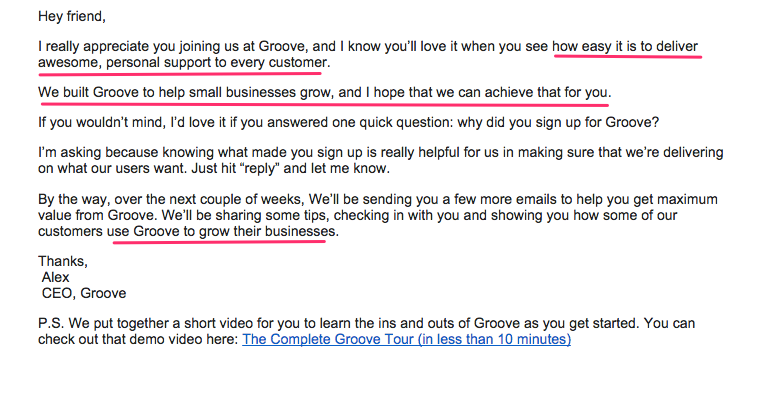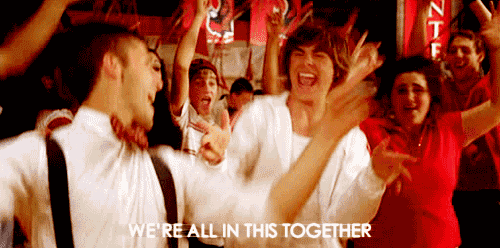4 Tips for Writing Email for Humans
Raise your hand if you’ve ever been guilty of sounding like a robot while writing a marketing email.

Why do we do this? Well, reputation, for one thing. We don’t want ourselves (or our companies) to come across as too casual or flippant. Writing like a robot is safe and uncontroversial.
Writing like a human can make you feel super vulnerable. What if they don’t like me?
It’s safer and objectively, easier, to just go robot mode:
We are pleased to present our new feature, {feature_name}. We hope you like it!
Sure, it gets the point across. But there’s nothing there to excite your reader! Nothing to make them click the button.
Writing helpful and friendly emails takes practice. Hopefully, you are willing to give it a real shot. Here are a few tips for writing in a relatable, engaging way.
1. Establish a Human Connection
Small differences in tone, purpose, and vocabulary can make or break your relationship with your users, especially in your first few interactions. This is why it’s critical to establish your connection with your readers first thing — for example, in your welcome emails.
Imagine that you see someone in public that you vaguely remember, and you’re feeling nervous because you don’t remember how you know them. They instantly break the tension by saying something like, “Hi Sara, it’s Freddie, we met at Mario’s open house last year.” This quick intro allows you to immediately jump into a meaningful conversation.
This is the kind of relief and guidance you’re trying to provide your new customer in your welcome emails. View it as an opportunity to help your customer understand your brand’s big-picture value to them. This might be your one shot to answer the question: Why should I read their emails?
Groove, a help desk platform, learned this tactic while testing onboarding emails. Initially, their post-signup welcome email jumped directly into product info and tips:

Although the tips are presented in a friendly and helpful way, the direct, product-driven approach to the body copy was still a little…off. The customer may or may not remember the specifics of Groove’s features or benefits, or even why they signed up.
The welcome email is an excellent opportunity to establish these important relationship facts. While a product-driven email would be super helpful later down the road, it’s a little direct for a welcome email.
Below is Groove’s revised welcome email. Notice the shift in tone and content from product to relationship. Rather than telling the customer what they should do, they’re expressing appreciation to the customer and establishing their relationship by telling a bit of the brand’s story.

In this email, they successfully:
- Establish the relationship: I really appreciate you joining us at Groove
- Establish their big-picture value: I know you’ll love it when you see how easy it is to deliver awesome, personal support to every customer.
- Get the customer to reflect on the relationship: I’d love it if you answered one quick question: Why did you sign up for Groove?
- Establish a channel for communication: Just hit “reply” and let me know.
It’s tempting to want to share product tips in early communications with users;but to write for humans, you first have to establish a human connection so that they are inspired to keep reading. Tell them who you are to them and why they should care. Then follow this guide for sending onboarding emails without nagging!
2. Use Human Names
Make sure you’re writing as a human, to a human. You want to send emails from real people with real names. You also want to use direct language like “you” and people’s first names, just like you’d talk in real life.
Why Using First Names Matters
One popular bit of Dale Carnegie advice said that to get people to like you, you should use their name frequently in conversation. Well that sounds like a great idea, Dale, does it work for email too?
Yes. Personalized subject lines are 22.2% more likely to be opened. Research by HubSpot found that one of the most effective personalization tactics is individualizing email campaign messaging.
As a recent example, Amazon Households, the service that helps manage multiple users of Amazon Echo, did a great job of helping me understand how sharing worked with multiple users. Throughout the email, Amazon used my partner’s name to help me understand how to share use of our Echo:

Kindle books that you’ve shared with Alex (or that they’ve shared with you) will not be displayed on the Kindle app on devices like your phone, tablet, or PC.
Ahh. This is a tiny detail that makes a big impact and I bet it felt more natural to write than if they had failed to personalize this message.
Direct References to You
In many languages, there are formal and informal ways of addressing someone. In my native Polish, for example, if you’re addressing someone older/more important than you, you’d call them either pan or pani, depending on their gender.
Using the more familial ty is good for family and close friends, but otherwise can be considered offensive to use (kind of like a snarky, “Hey you” to someone you don’t know).
In tech-y English, the opposite rule applies: Referring to someone by the friendly you establishes friendship — a kind of “we’re all in this together” kind of vibe.

Using more formal words, like users, can creates a distance that can detract from your relationship.
So, rather than saying:
Product X’s users love our floopyfloop feature.
You can say:
You’re going to love using the floopyfloop feature.
Here’s an example from an email I received from Amazon Households:
If you have enabled payment sharing, you can now share your digital content purchases across your Amazon devices and media applications.
Imagine how indirect and funky this same message would feel if it had read:
Users can share digital content purchases across their Amazon devices and media applications after enabling payment sharing.
That would make me think:

3. Set the Right Tone
Appropriate punctuation and language are very important when writing for humans because it can change the tone. When it comes to punctuation, you don’t want to overwhelm with excitement or underwhelm with calm.
This means using all punctuation as intended. If the statement is exciting, slap an exclamation point on it! If it isn’t, don’t.
A mentor once told me this:
You’ll get one, maybe two, occasions in your lifetime in which using a triple exclamation point is acceptable. Use it wisely.
Messages like shipment confirmations, order confirmations, and welcome emails should be full of excitement. But others such as password reset emails should be more serious in tone.
4. Connect the Dots
As a writer in business, your goal is to connect the dots from A to B to C. This means writing subject lines that accurately explain the contents of your email, section headers that effectively summarize the copy underneath them, and buttons that go to logical places.
Connecting the dots for your readers matters because you want your email to make sense. But more importantly, you want your reader to trust you. If your readers click your subject line and don’t see what they were expecting, they won’t feel as confident about clicking the next one.
Here’s a great example of how Nuts.com connected the dots for me. In this email, they are asking me to fill out a survey in exchange for $5 off my next order. The subject line read:

After reading this, I figured I would be led to a survey or a link to a survey. I also hoped to learn how I’d receive my $5.
The body looked like this:

As expected, the body copy describes the survey, and then explains exactly how I would receive my $5. Then there is a large button leading me to the survey that reads: Take me to the survey. Perfect!
The Real Differences
The people who read your marketing emails are just like the people who read your Facebook posts, just in a different context. They still like to be entertained and engaged.
Talk to them like you’re talking to real people — because you are. Once you understand this concept, your writing will improve.